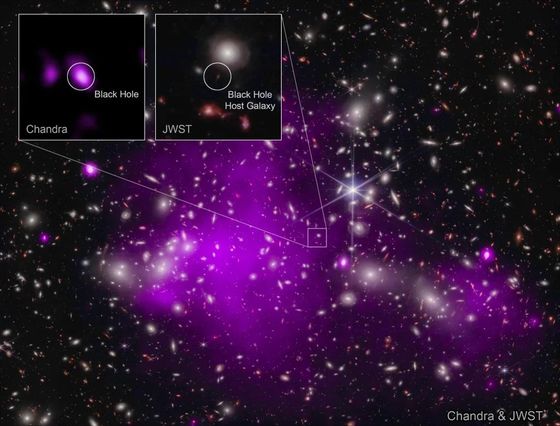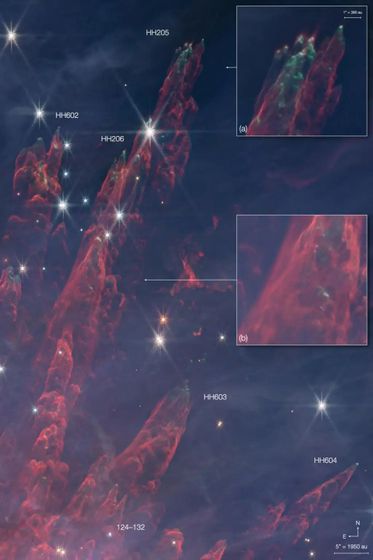Top 15 dramatic images taken by the James Webb Space Telescope in 2023, including the most distant black hole and supernova remnant 'Crab Nebula'

by
The James Webb Space Telescope , an ultra-high-performance space telescope launched by NASA in 2021, will complete various adjustments and begin full-scale operation in July 2022, and 2023 will be the first time it has operated for a full year. It's the year of the year. The science media Big Think is introducing ``Top 15 Dramatic Images Taken by the James Webb Space Telescope in 2023''.
The top 15 JWST images of 2023 - Big Think
https://bigthink.com/starts-with-a-bang/top-jwst-images-2023/
◆1: The most distant black hole ever observed
By combining infrared images from the James Webb Space Telescope with X-ray data from Chandra , researchers have discovered the existence of a black hole behind the Pandora galaxy cluster (Abell 2744) , located 13.2 billion light years away , the farthest ever observed. revealed. The mass of the black hole is approximately the same as that of the galaxy containing the black hole, UHZ1 , and approximately 10 to 100 million times the mass of the sun.

◆2: Supernova remnant “Crab Nebula”

◆3: Viewer including the most distant galaxies
As part of

◆4: Inside the Orion Nebula

◆5: Farthest gravitational lens ever
The image below shows how the gravity of a small, heavy galaxy located approximately 17 billion light years away distorts the light of a galaxy 21 billion light years away into a ring shape. When there is a heavy celestial body between a star and the Earth, a phenomenon called `` gravitational lensing '' occurs, which causes the light of distant stars to appear bent. The newly discovered galaxy is a small, heavy object that causes gravitational lensing, and it is said to be the farthest object that causes gravitational lensing.

◆6: Massive galaxy cluster “Elgordo” with a mass of more than 2,000 trillion suns
The

◆7: The most distant red supergiant star ever
In the same region as Elgordo, Quyllur, the most distant

◆8: Triple lens “H0pe supernova”
Light emitted by distant celestial bodies can be divided into multiple images by gravitational lenses, but the ``

◆9: Inside a spiral galaxy
Many images of

◆10: Ring Nebula

◆11: Saturn's rings
Saturn itself is a relatively cool star and appears dark in the infrared light of the James Webb Space Telescope, but the rings around Saturn are made of 99.9% ice and have a higher reflectance of infrared light than the planet itself. It looks bright. Saturn's rings are named 'A ring', 'B ring', etc. along several widths, and in the image below, the A ring, B ring, C ring, and F ring can be clearly identified. .

◆12: Rings of Uranus
The James Webb Space Telescope has also released beautiful images of Uranus' rings. You can understand why the rings of Uranus are facing us by reading the article below.

◆13: Sparkler Galaxy
In 2023, it was revealed that an image taken by the James Webb Space Telescope in 2022 has a feature called a ' Sparkler galaxy .' The sparkler-like light surrounded by a yellow frame in the image below is the light from stars forming in a distant globular cluster that is stretched out by the gravitational lens in the foreground. It is known that there are known star clusters inside these globular clusters, suggesting that 'secondary star formation' is occurring inside them.

◆14: Fomalhaut star system
When we observed the star

◆15: The most distant galaxy cluster ever observed
Observations using the James Webb Space Telescope have confirmed that the primordial galaxy cluster A2744z7p9OD is the most distant galaxy cluster in history, located 13.14 billion light years away.

Related Posts:
in Science, Posted by log1h_ik







